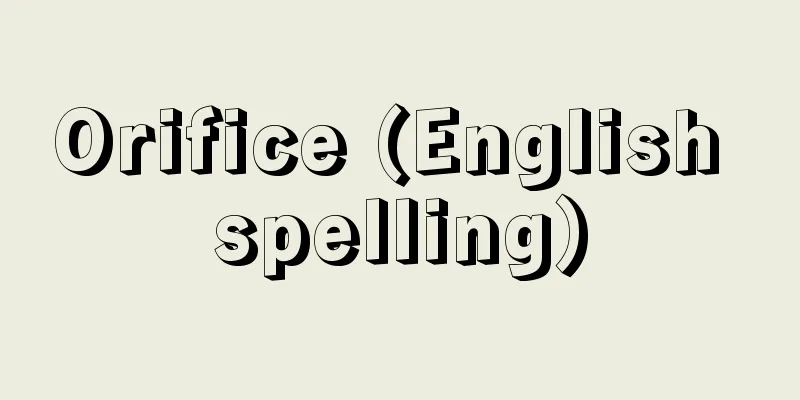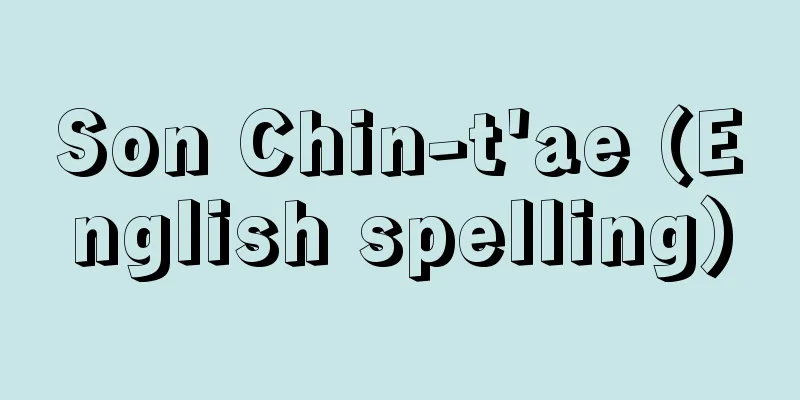Pornography - pornography

|
A general term for novels, paintings, films, photographs, etc. that aim to stimulate human sexuality or sexual arousal, and is often used to refer to modern, Western works, as distinguished from traditional erotic literature. In the 18th century in the West, works such as John Cleland's (1709-89) Fanny Hill (1748-49) and the Marquis de Sade's Justine (1791) came out, and the hedonism of Sade and Casanova became popular, which was called the Golden Age of pornography, but it was mainly for a small group of aristocrats and the big bourgeoisie. In the 19th century, the market expanded as printing technology developed and the middle class gained the ability to read and economic power, and photography was invented. This led to the publication of many books such as "Autobiography of a Flea" (1887), "Venus of India" (1889), "Flossie" (1897), "My Secret Life" (around 1885), as well as magazines such as "Pearl" and "Boudoir." A great deal of pornography proliferated, but a censorship system was established because it was considered to be a disturbance to public order. In the 20th century, censorship continued, but in the 1960s, the United States abolished all laws prohibiting the sale, display, and distribution of pornography to adults, based on a report by 19 experts consulted by President Johnson, and Denmark, Sweden, Israel, the United Kingdom, and other countries also lifted their bans in the 1970s. In Japan, there is the ancient Heian period's Osokuzu (shunga) and the Kamakura and Muromachi periods' love scrolls such as Koshibagaki-zoshi, Chigo-zoshi, and Fukuroboshi Ekotoba. In the Edo period, there was a wealth of pornography, including secret caricatures known as makura-e and abuna-e, ukiyo-e, and the collection of sexual senryu poems called Haifusuetsumuhana, as well as works such as Azuma Kagami, Azuma Kagami, Azuma Kagami, Anaokashi, and Hakoya no Himegoto. In 1790 (Kansei 2), the shogunate's senior councilor Matsudaira Sadanobu issued a ban on publishing. After World War II, with the trend towards sexual liberation, pornographic magazines that did not violate censorship standards flourished even in Japan, one of the few countries where pornography was not banned, and there were many pornographic films (pink films) and videos that featured specific sexual depictions. [Noh Sato] Pornography and the lawIn Japan, pornography is legally considered "obscene material" (obscene documents, drawings, sculptures, films, audio tapes, videos, etc.; with the 1995 revision of the Penal Code, which aimed to make it colloquial, the kanji spelling of the word "obscene" was changed and the legal spelling of the word "wasetsu"), and its distribution, sale or public display is prohibited (Article 175 of the Penal Code). However, not all pornography constitutes obscene material, and the standards for determining whether it is obscene change over time. This issue is sometimes discussed in relation to freedom of expression. In a Supreme Court Third Petty Bench ruling on the sale of so-called vinyl books (erotic publications sealed in plastic bags) (March 8, 1983), the court drew attention by issuing a supplementary opinion that, in cases where the issue is whether documents and drawings fall under the concept of "obscenity," it is appropriate to distinguish between so-called hard-core pornography (works with direct sexual depictions) and works that do not fall under this category but have strong "obscene" elements (quasi-hard-core pornography). This supplementary opinion stated that subsequent punishment or sanctions against the former are outside the scope of protection under Article 21, paragraph 1 (freedom of expression) of the Constitution of Japan, and that when the latter are subject to regulation under the Criminal Code, it is essential to balance the degree of harm caused by the sexual expression in question with the social value of the work in order to determine whether it is obscene (by comparing and weighing conflicting interests and giving priority to one of the values). [Masao Horibe] Internet pornography regulationSince the mid-1990s, as the Internet began to spread rapidly, Internet pornography became a major social problem, and it was decided to address it by amending existing laws or enacting new laws. The revised Entertainment and Amusement Business Control Law (Act on the Control and Proper Management of Entertainment and Amusement Businesses, etc.) that came into effect on April 1, 1999 (Heisei 11) (also revised in 2001) included the following provisions: (1) A business that primarily involves showing images of sexual acts or undressed people in order to arouse sexual curiosity and transmits such images to customers using telecommunications facilities (excluding those that fall under broadcasting or cable broadcasting) is defined as a "video transmission-type sexual entertainment special business" (Article 2-8 of the same law), and those who operate such businesses are required to notify the Public Safety Commission (Article 31-7 of the same law). (2) When an automatic public transmission device installer (provider) learns that a person engaged in a video transmission-type sexual entertainment special business has recorded obscene images or child pornography images (images showing a child's pose as stipulated in any of the items of Article 2, Paragraph 3 of the Law Punishment for Child Prostitution described below; the term "child pornography images" was inserted in the 2001 amendment), the installer must endeavor to take the necessary measures to prevent the transmission of such images (Article 31-8 and Paragraph 5 of the same Law). [Masao Horibe] Child pornography regulations In addition, the Child Prostitution Punishment Law (Law on Punishment of Acts Related to Child Prostitution and Child Pornography and Protection of Children), which came into force on November 1, 1999, defines child pornography as photographs, videotapes and other items, [Masao Horibe] "Freedom of Sexual Expression" by Horibe Masao (included in "Lecture Series on Modern Society and Communication 3: Freedom of Speech", 1974, University of Tokyo Press)" ▽ "Freedom of Expression and Criminal Regulation" by Sone Takehiko (1985, Ichiryusha) " ▽ "Freedom of Sexual Expression" by Okudaira Yasuhiro, Tamaki Shoichi, and Yoshiyuki Junnosuke (1986, Yuhikaku) " ▽ "The Target Sexuality of Children: Child Prostitution, Pornography, and Sexual Abuse" by Judith Ennew, translated by Kaino Tamie, Sakata Chizuko, and Hirabayashi Mitsuko (1991, Keibunsha)" ▽ "Pornography: Between 'Equality' and 'Freedom of Expression'" by Catherine A. MacKinnon, translated by Kakigi Kazuyo (1995, Akashi Shoten)" ▽ "Freedom to Sex, Freedom from Sex: The Historical Sociology of Pornography" by Akagawa Manabu (1996, Seikyusha)" ▽ "Aoki Hideo, Illustrated Guide to Banned Books of the World - European Classics (1999, Kawade Shobo Shinsha)" ▽ "Sonoda Hisashi, Commentary on the Law Concerning the Punishment of Child Prostitution and Child Pornography (1999, Nippon Hyoronsha)" ▽ "Shirakura Takahiko, Tanaka Yuko et al, Reading Ukiyo-e Shunga, Volumes 1 and 2 (2000, Chuokoron-Shinsha)" ▽ "Arakawa Hiroshi, Erotopolis: A Sexual View of the History of Humanity (Shueisha Bunko)" [References] | | | | | | | |Source: Shogakukan Encyclopedia Nipponica About Encyclopedia Nipponica Information | Legend |
|
人間の性または性的興奮の誘発を目的とする小説、絵画、映画、写真などの総称で、略してポルノともいい、伝統的な好色文学とは区別して現代的、西洋的なものについていうことが多い。西洋では18世紀にジョン・クレランドJohn Cleland(1709―89)の『ファニー・ヒル』(1748~49)、マルキ・ド・サドの『ジュスチーヌ』(1791)などが出てサドやカサノーバの快楽主義が流行し、ポルノグラフィーの黄金時代といわれたが、もっぱら一部の貴族や大ブルジョアのものであった。19世紀になり、印刷技術の発達と、中産階級が読書の能力と経済力をもつようになって市場が広がり、また写真が発明されるなどして、『蚤(のみ)の自伝』(1887)、『インドのビーナス』(1889)、『フロッシー』(1897)、『わが秘密の生涯』(1885ころ)などのほか、雑誌も『パール』『ブードア』など数多く発刊されておびただしいポルノグラフィーが氾濫(はんらん)したが、良風秩序を害するというので検閲制度も設けられるに至った。20世紀に入り、検閲は依然として行われたが、1960年代にアメリカでは、大統領ジョンソンの諮問を受けた19名の有識者の報告に基づいて、成人に対するポルノグラフィーの販売・陳列・配布の禁止に関する法律をすべて撤廃し、ついでデンマーク、スウェーデン、イスラエル、イギリスその他の諸国も1970年代にそれぞれ解禁した。 日本では、古くは平安時代の偃息図(おそくず)(春画)や鎌倉・室町時代の愛欲絵巻『小柴垣(こしばがき)草子』『稚児(ちご)草子』『袋法師絵詞(えことば)』があり、江戸時代には枕絵(まくらえ)・あぶな絵などとよばれる秘戯画や浮世絵、性的川柳(せんりゅう)を収集した『誹風末摘花(はいふうすえつむはな)』ほか『好色吾妻鑑(あづまかがみ)』『好色床談義』『阿奈遠可志(あなおかし)』『藐姑射秘言(はこやのひめごと)』など多くのポルノグラフィーにあふれ、1790年(寛政2)には幕府の老中松平定信(さだのぶ)により板行禁止令も施行されるに至った。第二次世界大戦後は、性解放の風潮に伴い、数少ないポルノグラフィー非解禁国である日本でも、検閲規準に微妙に触れぬ表現のポルノ雑誌が隆盛を極め、ポルノ映画(ピンク映画)、ポルノビデオなど具体的なセックス描写を扱った作品が数多くみられる。 [佐藤農人] ポルノグラフィーと法規制ポルノグラフィーは、日本では法律上「わいせつ物」(猥褻(わいせつ)の文書、図画、彫刻、映画、録音テープ、ビデオなど。なお1995年の刑法改正で口語化が図られたのに伴い、漢字表記も改められ従来の「猥褻」は法律上「わいせつ」と表記されるようになった)にあたるとして、その頒布、販売または公然陳列が禁止される(刑法175条)が、ポルノがすべて猥褻物に該当するわけではなく、その判断基準などは時代によって変化する。この問題は表現の自由との関連で議論されることがある。いわゆるビニール本(ビニル袋に密封された扇情的出版物)の販売事件に関する最高裁判所第三小法廷判決(1983年3月8日)で、文書図画が「猥褻」の概念に該当するかどうかが問題とされる場合において、いわゆるハード・コア・ポルノ(性描写が直接的な作品)と、それにはあたらないが「猥褻」的要素の強いもの(準ハード・コア・ポルノ)とを区別して考えるのが適当である、という補足意見が述べられて注目を集めた。この補足意見は、前者に対する事後の処罰や制裁は日本国憲法第21条第1項(表現の自由)の保護の範囲外にあり、後者を刑法の規制の対象とするときは、猥褻の判断にあたり、当該性表現によってもたらされる害悪の程度と作品の有する社会的価値との利益衡量(対立する諸利益を比較衡量していずれかの価値を優先させること)が不可欠となるとした。 [堀部政男] インターネット・ポルノ規制1990年代中葉以降、インターネットが急速に普及し始めたのに伴い、インターネット・ポルノが大きな社会問題になり、現行法を改正しまたは新法を制定することによって対応することになった。1999年(平成11)4月1日施行の風俗営業等取締法(風俗営業等の規制及び業務の適正化等に関する法律)改正法(2001年にも改正)では、次のような規定が盛り込まれた。 (1)もっぱら、性的好奇心をそそるため性的な行為を表す場面または衣服を脱いだ人の姿態の映像を見せる営業で、電気通信設備を用いてその客に当該映像を伝達すること(放送または有線放送に該当するものを除く)により営むものを「映像送信型性風俗特殊営業」と定義し(同法2条8項)、これを営む者に公安委員会への届出を義務づける(同法31条の7)。 (2)自動公衆送信装置設置者(プロバイダー)が、映像送信型性風俗特殊営業を営む者が猥褻な映像または児童ポルノ映像(後述の児童買春処罰法第2条第3項各号に規定する児童の姿態に該当するものの映像をいう。この「児童ポルノ映像」は2001年改正法で挿入された)を記録したことを知ったときは、その送信を防止するため必要な措置を講ずるよう努めなければならないとする(同法31条の8、5項)。 [堀部政男] 児童ポルノ規制また、1999年11月1日施行の児童買春処罰法(児童買春、児童ポルノに係る行為等の処罰及び児童の保護等に関する法律)では、児童ポルノ(子どもポルノ)とは、写真、ビデオテープその他の物であって、 [堀部政男] 『堀部政男著「性表現の自由」(『講座現代の社会とコミュニケーション3 言論の自由』所収・1974・東京大学出版会)』▽『曽根威彦著『表現の自由と刑事規制』(1985・一粒社)』▽『奥平康弘・環昌一・吉行淳之介著『性表現の自由』(1986・有斐閣)』▽『ジュディス・エニュー著、戒能民江・坂田千鶴子・平林美都子訳『狙われる子どもの性――子ども買春・ポルノ・性的虐待』(1991・啓文社)』▽『キャサリン・A・マッキノン著、柿木和代訳『ポルノグラフィ――「平等権」と「表現の自由」の間で』(1995・明石書店)』▽『赤川学著『性への自由・性からの自由――ポルノグラフィの歴史社会学』(1996・青弓社)』▽『青木日出夫著『図説世界の発禁本――ヨーロッパ古典篇』(1999・河出書房新社)』▽『園田寿著『解説 児童買春・児童ポルノ処罰法』(1999・日本評論社)』▽『白倉敬彦・田中優子他著『浮世絵春画を読む』上下(2000・中央公論新社)』▽『荒俣宏著『性愛人類史観 エロトポリス』(集英社文庫)』 [参照項目] | | | | | | | |出典 小学館 日本大百科全書(ニッポニカ)日本大百科全書(ニッポニカ)について 情報 | 凡例 |
<<: Holbein (English spelling)
>>: Bollnow (English spelling) Otto Friedrich Bollnow
Recommend
Qawwali
A religious hymn of Muslims in India, Pakistan, an...
Pharmacist - Kusushi
An old name for a doctor. The character "I&q...
Sava Tekelija (English spelling)
1761‐1842 Yugoslav social worker. Although he was ...
"Kiyine Mondo" - Kirei Mondo
...Shosatsurei refers to the entire set of ceremo...
Aswan Dam - Aswan Dam
A multipurpose dam on the Nile River, 5 km south o...
Inami [town] - Inami
A former town in Higashitonami County in western T...
Gatterer, JC - Gatterer
...In the 18th century (link), geography was defi...
Mid Ocean Dynamics Experiment
...The group was comprised mainly of American mar...
Momijiyama
A small hill between the Honmaru and Nishimaru of ...
Hindenburg - Paul von Beneckendorff and von Hindenburg
German military officer and politician. Son of a ...
Gibbs statistical mechanics
…However, the calculation of R or W is only feasi...
Mitchell, M.
...A full-length novel by the American female wri...
Corella japonica
Phylum Protochordata, Subphylum Urochordata, Class...
Gakushu Kiln
"...Sometimes Xingzhou is placed above Yuezh...
Rain coat - Amabaori
〘Noun〙 A haori made of cotton or other materials w...


![Warabi [city] - Warabi](/upload/images/67cd4377e6715.webp)






